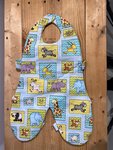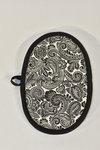History of Amish Quilts
A History of Amish Quilting:
The Amish started quilting around the 1870's. Because the Amish keep a distance from modern conveniences and pleasures, quilting was at first a temptation that they resisted. This perception changed over time and eventually quilting became a part of the Amish lifestyle. Though many people look at Amish quilts for their artistic value, it was the practicality of quilts and their function of keeping their family warm on cold nights that led the Amish to embrace the quilt making tradition.
Amish quilts originated in plain, simple and solid fabrics, much like their deep, dark solid conservative attire—usually brown, rust or black. Although the fabric was simple, the intriguing quilting designs on them were very elaborate. Over the years Amish quilts have slowly evolved. Modifications in quilt patterns and colors were made within the community only after much processing and discussion over the changes. Decisions are not made without community consensus, whether they pertain to a quilt or other lifestyle issues. When the bright vivid colors, complex patterns and printed fabrics were incorporated into quilts, this decision had to be accepted and approved by the community. Today more individual discretion is given in how quilts are designed and what patterns are used, leading to the beautiful and colorful Amish quilts that we know and love.
 The community is central to Amish experience and existence. Family and friends work together on projects like helping with a crop, building a barn or piecing together a quilt. This commitment to community is necessary for people surviving on family farms. It is even harder on an Amish farm, where the convenience of modern day appliances is absent. Everyone, even small children, share in the responsibilities of farm work. Therefore, Amish women usually find more time for quilting in the snowy, cold winters than in the busy spring and summer when they are canning food, planting flowers or harvesting crops. Most quilts are done by one woman, but it is common to have a quilting circle (or quilting bee), where family and friends gather around the quilt frame to help quilt the patches that have been pieced together. This is a time for women to socialize as well as share in something that they love to do. In this sense, quilting is often part of the fabric of the Amish community.
The community is central to Amish experience and existence. Family and friends work together on projects like helping with a crop, building a barn or piecing together a quilt. This commitment to community is necessary for people surviving on family farms. It is even harder on an Amish farm, where the convenience of modern day appliances is absent. Everyone, even small children, share in the responsibilities of farm work. Therefore, Amish women usually find more time for quilting in the snowy, cold winters than in the busy spring and summer when they are canning food, planting flowers or harvesting crops. Most quilts are done by one woman, but it is common to have a quilting circle (or quilting bee), where family and friends gather around the quilt frame to help quilt the patches that have been pieced together. This is a time for women to socialize as well as share in something that they love to do. In this sense, quilting is often part of the fabric of the Amish community.
The Amish view a woman's ability to create a quilt as a gift from God that should be used to its fullest ability. Children are taught to quilt starting at around four years of age, which explains the expert stitching seen in Amish quilts. The quilters?individual personalities come through in their creations. No two quilters quilt quite the same. Each quilt is a creation that cannot be replicated and makes a statement about its creator.
Amish Quilting Today -
The popularity of Amish quilts in the broader population has resulted in a resurgence of interest in them as unique works of art. Increasingly, more and more people want their own original Amish quilt—not only for its practical value, but also for its artistic value. Amish quilts have even been celebrated on commemorative stamps with the U.S. Postal Service and in many museums and art galleries. Amish quilts have also been included in a selection of quilts at the National Collection in the Smithsonian National Museum of American History.
Along with the traditional use of covering a bed, today quality quilts are often used to decorate walls or displayed as artwork. Amish-made quilted pillows, table runners and small wall hangings are also now available.
 Quilts have rich symbolic significance as a family heirloom and expression of the values of family and faith. Today many churches are displaying quilts at their altars. Brides are using them as wedding canopies. Many are buying quilts as presents for a wedding, birthday, friendship or birth of a baby. Quilts are also a popular item for fund-raisers. There are as many uses for quilts as there are quilt patterns, and the quality of Amish-made quilts makes them the perfect choice for any use.
Quilts have rich symbolic significance as a family heirloom and expression of the values of family and faith. Today many churches are displaying quilts at their altars. Brides are using them as wedding canopies. Many are buying quilts as presents for a wedding, birthday, friendship or birth of a baby. Quilts are also a popular item for fund-raisers. There are as many uses for quilts as there are quilt patterns, and the quality of Amish-made quilts makes them the perfect choice for any use.
Amish Quilting Defined -
The term “Amish Quilt?is used to describe (1) quilts using any combination of the traditional Amish quilt block patterns and fabrics or (2) quilts made by an Amish or Mennonite quilter. Because of these two definitions, a quilt might be called “Amish?when it is not made by an Amish woman. We have chosen to use the second definition when selecting our quilts. All of our quilts are hand made by Amish and Mennonites in Lancaster County, Pennsylvania and Sarasota, Florida. Because Amish and Mennonites share similar cultural habits and belief systems and have lived alongside each other since immigrating to the United States, their quilting history and styles are the same and the term “Amish Quilt?is fitting for both.
70,





